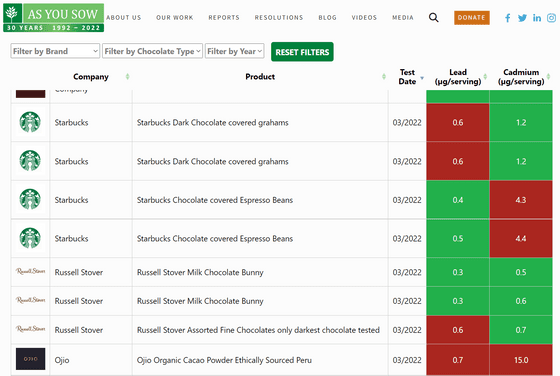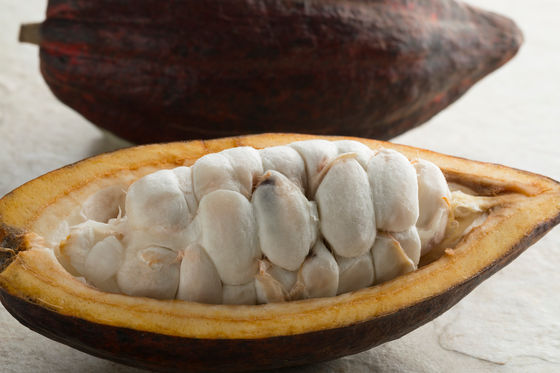Research report that chocolate contains ``cadmium and lead above the standard value'', experts advocate measures to reduce harmful substances

As You Sow, a non-profit organization pursuing corporate social responsibility, and the National Confectioners Association (NCA) organized by the American confectionery industry jointly announced a long-term effort to reduce cadmium and lead contained in chocolate. Did. In the background, research has shown that many common chocolate confections contained warning levels of cadmium and lead.
Research Reveals Ways Lead and Cadmium in Chocolate May be Reduced - NCA
New Report Details Simple, Safe, and Low-Cost Solutions to Reduce Levels of Lead and Cadmium in Chocolate — As You Sow
https://www.asyousow.org/blog/2022/8/17/new-report-explains-simple-safe-and-low-cost-solutions-to-reduce-levels-of-lead-and-cadmium- in-chocolate
In addition to being rich in nutrients such as cacao polyphenols, chocolate has been reported to have the effect of improving cognitive function, so dark chocolate with a high cacao content and low sugar content is particularly good for the body. It has been. However, in a 2014 study conducted by As You Sow, 285 out of 469 brands of chocolate confectionery were found to have ' Maximum Allowable Dose Levels ,' which is the level at which California law stipulates warning labeling as causing reproductive dysfunction. It was found to contain cadmium and lead in excess of the MADL (Maximum Permissible Dose Level for Reproductive Toxic Substances) .
Some of the brands that exceeded MADL include brands familiar to Japanese people such as Starbucks and Godiva.
Toxic Chocolate—As You Sow
https://www.asyousow.org/environmental-health/toxic-enforcement/toxic-chocolate

Cadmium is known to damage kidneys, liver, bones, etc., and to have
With regard to chocolates with particularly high cocoa content, the National Consumer Affairs Center of Japan said, 'The amount of cadmium content was not so high that it would cause an immediate health hazard, but there was a large difference in cadmium content between brands. Appropriate quality control, etc. is still desired.' I have reported the results of the investigation (PDF file) .
In response to these concerns and the aforementioned findings, As You Sow and the NCA formed an interdisciplinary panel of four experts to spend three years identifying the sources of toxic substances in chocolate and cocoa and how to reduce them. was investigated.
According to the results of the survey, the cadmium in chocolate and cocoa is derived from the tropical soil where cocoa is grown. Cadmium taken from the roots of the cacao tree is deposited in the endosperm (cacao nibs), which is the core of the cacao bean and is the raw material of chocolate and cocoa. Especially in Central and South America and the Caribbean region, which are famous cacao production areas, cacao with rich flavor is harvested, but the amount of cadmium in the soil tends to be high.

Therefore, as a way to reduce the cadmium content without reducing the taste, in the short term, we can blend cocoa beans with low cadmium content and cocoa beans with high cadmium content, and in the long term, soil improvement and genetic improvement of cacao need to be done, experts concluded.
Lead, on the other hand, is not taken up by the roots, but is mixed into chocolate by adhering to cacao, which is the raw material, from lead contained in soil, dust, and sediment from power plants. In particular, the cocoa beans extracted from the cacao pods have a sticky cacao pulp called “baba”, which means that the cocoa pulp is attached. It is easy to attach.

In this respect, experts should optimize the removal of contaminants during the washing, roasting and dehulling processes of cocoa beans, which chocolate manufacturers are already doing, as well as the removal of soil during the harvesting process. He pointed out that minimizing fouling and exposure to air can reduce lead levels in the final product.
By implementing the cadmium and lead countermeasures proposed this time, it is expected that lead content will be greatly reduced in one year. On the other hand, the reduction of cadmium is a long-term issue because it requires soil improvement and the introduction of new farming methods.
Daniel Fougère, President and Chief Advisor of As You Sow, said: 'The study conducted by the Expert Panel is important in identifying practical ways to reduce lead and cadmium in chocolate products. We would like to thank the chocolate industry for their cooperation in funding this three-year study, and look forward to working with them to move the initiative into implementation and reduce cadmium and lead content. I'm looking forward to it,' he commented.
Christopher Gindlsperger, NCA's vice president of public affairs, also said, 'Our association and members of the chocolate industry have agreed with As You Sow on Proposition 65 that the expert committee's findings have been funded. We would like to continue working together to implement measures that are possible and feasible to assure the quality and safety of products so that consumers can continue to enjoy delicious chocolate.” I talked to
Related Posts:
in Food, Posted by log1l_ks







